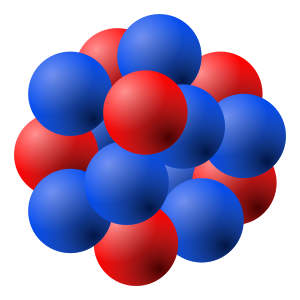
The nucleus of an atom is the very small dense region of an atom, in its centre consisting of nucleons (protons and neutrons). The size (diameter) of the nucleus is in the range of 1.6 fm (10-15 m) (for a proton in light hydrogen) to about 15 fm (for the heaviest atoms, such as uranium). These dimensions are much smaller than the size of the atom itself by a factor of about 23,000 (uranium) to about 145,000 (hydrogen). Almost all of the mass in an atom is made up from the protons and neutrons in the nucleus with a very small contribution from the orbiting electrons. The etymology of the term nucleus is from 1704 meaning “kernel of a nut”. In 1844, Michael Faraday used the term to refer to the “central point of an atom”. The modern atomic meaning was proposed by Ernest Rutherford in 1912.[1] The adoption of the term “nucleus” to atomic theory, however, was not immediate. In 1916, for example, Gilbert N. Lewis stated, in his famous article The Atom and the Molecule, that “the atom is composed of the kernel and an outer atom or shell”.